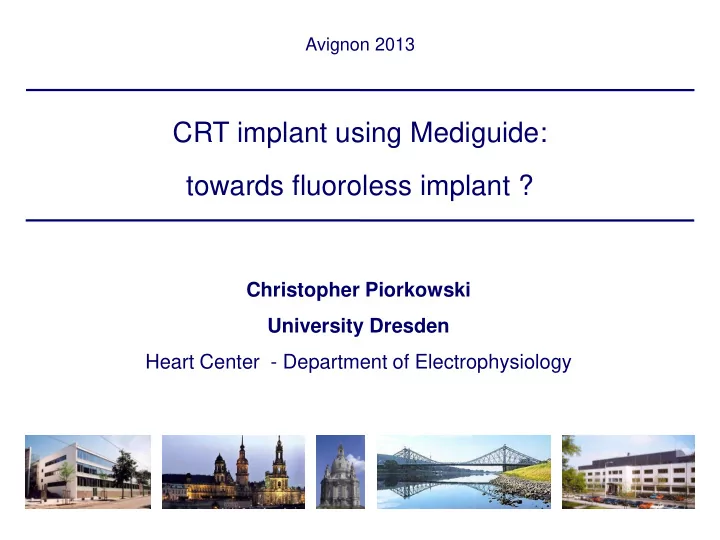

Avignon 2013 CRT implant using Mediguide: towards fluoroless implant ? Christopher Piorkowski University Dresden Heart Center - Department of Electrophysiology
Avignon 2013 Presenter Disclosure Information C. Piorkowski has the following disclosures Lecture honoraria: St. Jude Medical, Biotronik, Advisory board member: St. Jude Medical, Siemens Research support: St. Jude Medical, Biotronik, Imricor, Philips
Avignon 2013 CRT – current standard • indications according to current guidelines: EF < 35%, LVEDD > 55 mm NYHA III/IV despite optimal medical therapy QRS > 150 ms or QRS > 120 ms + Echo-Asynchrony CRT-HSM Event-free Survival (%) Event-free Survival (%) p=0.014 CRT-HSM CRT-ICD p=0.010 Pharmacologic Pharmacologic therapie therapie Days after Randomization Days after Randomization COMPANION CARE-HF
Avignon 2013 CRT – Difficulties met in daily clinical practise • Indication in patients not covered by current guidelines • Difficulties during the implantation procedure • Technical challenges • Anatomical challenges • Leading to long procedures with extensive radiation/contrast • CRT non-response despite • valid indication, implantation and therapy delivery
Avignon 2013 Challenges during CRT implantation narrow ostium valves left SVC target vein kinking
Avignon 2013 • mean TFT 20.3 min • mean DAP 111 Gy*cm 2 PACE 2010;33:1003-1012
Avignon 2013 Imaging of CS anatomy Limitations: – static 3D anatomical model – moving implantation targets (cardiac and respiratory motion) – moving delivery tools – not integrated within the 3D environment
Avignon 2013 Mediguide technology: Auto-registration of device tracking and cardiac image 3D electromagnetic field emitters integrated into X-ray detector Tracking of MPS sensor intracardiac devices equipped with sensors
Avignon 2013 Sensor devices and their potential clinical applications EP Catheters 1mm Intracardiac Sheaths 0.27mm Guidewires 9
Avignon 2013 Mediguide enabled LV lead placement – first in human Site: University of Leipzig - Heart Center Investigators: Dr. Piorkowski, Dr. Gasper, Dr. Doering, Dr. Richter, Prof. Hindricks Purpose: Evaluate safety and performance of MediGuide system and tools for LV lead implant Sample size: Maximum of 15 cases; feasibility study Inclusion criteria: Patients indicated for CRT implant Data Collected: • Procedural success rate of LV lead implantation • Total fluoroscopy time & radiation exposure • Procedure time; Amount of contrast used; Safety Status: • EC approval received Jan 16 th ; training completed January 18 th • First case – Jan 19 th ; Last case – Feb 29 th
Avignon 2013 Mediguide enabled LV lead placement – first in human
Avignon 2013 Introduction of Mediguide sheath Richter et al., Circulation A+E 2013
Avignon 2013 CS cannulation with sheath and EP catheter Richter et al., Circulation A+E 2013
Avignon 2013 Placement of landmark at CS ostium Richter et al., Circulation A+E 2013
Avignon 2013 Acquisition of CS angiograms, “biplane” modus Richter et al., Circulation A+E 2013
Avignon 2013 Attempt to access target vein with guidewire Richter et al., Circulation A+E 2013
Avignon 2013 Target vein access with sub-selector and guidewire Richter et al., Circulation A+E 2013
Avignon 2013 Lead deployment within motion compensated 2D overlay Richter et al., Circulation A+E 2013
Avignon 2013 Mediguide enabled CRT implant – key observations – Implant success rate : 15/15 (100%) cases – Intra procedural complications : – lead dislodgement while sub-selector slitting n=2 – target vein perforation n=1 – Fluoroscopy needed during CS cannulation : – in 12/15 cases fluoroscopy was not needed for CS cannulation – Median total fluoroscopy time: 5.2 (3.0 ; 8.4) min – Median LV lead implant fluoroscopy time: 2.6 (1.8 ; 5.8) min – Very difficult implantation: 2/15 (13%) with severe target vein kinking – one case: conversion to X-ray based delivery after lead dislodgment – one case: conversion to X-ray based delivery after vein perforation
Avignon 2013 Mediguide enabled LV lead placement – next steps • Evaluation of potential clinical benefits – significant fluoroscopy reduction - likely – shortening of the procedure - needs to be assessed – implantation success - needs to be assessed • Later on use of the technology to – perform basic science on concept and development of CRT – potentially come out with strategies for • tailored lead placement, device optimization
Avignon 2013 Study on Mediguide enabled LV wall motion analysis • Mediguide enabled analysis of 4D LV wall motion in – 10 patients with structural normal hearts – 10 patients with heart failure and narrow QRS – 10 patients with heart failure wide QRS • Study procedure – Mediguide enabled endocardial LV wall motion mapping – Mediguide enabled epicardial LV wall motion mapping • Primary objective is to – to collect data on 4D wall motion behavior relevant for CRT
Avignon 2013 Study on Mediguide enabled LV wall motion analysis • 72 year-old male • Sustained monomorphic VT; Ischemic cardiomyopathy • Non-classical LBBB with left anterior hemiblock • Intrinsic QRS width 180ms; EF 21%; NYHA II • Dual-chamber ICD first implanted in 2002
Avignon 2013 Study on Mediguide enabled LV wall motion analysis RAO LAO
Avignon 2013 Summary • Cardiac anatomy is crucial for challenging CRT implantations • Mediguide tracking technology allows – integration of CRT delivery tools into the cardiac target anatomy – compensation of primary and secondary organ motion • Mediguide has been successfully used for in-human CRT implants • the first clinical use indicated: – significant impact on procedural aspects (fluoroscopy) • further scientific expectations: – individual LV wall motion analysis to tailor CRT delivery
Recommend
More recommend